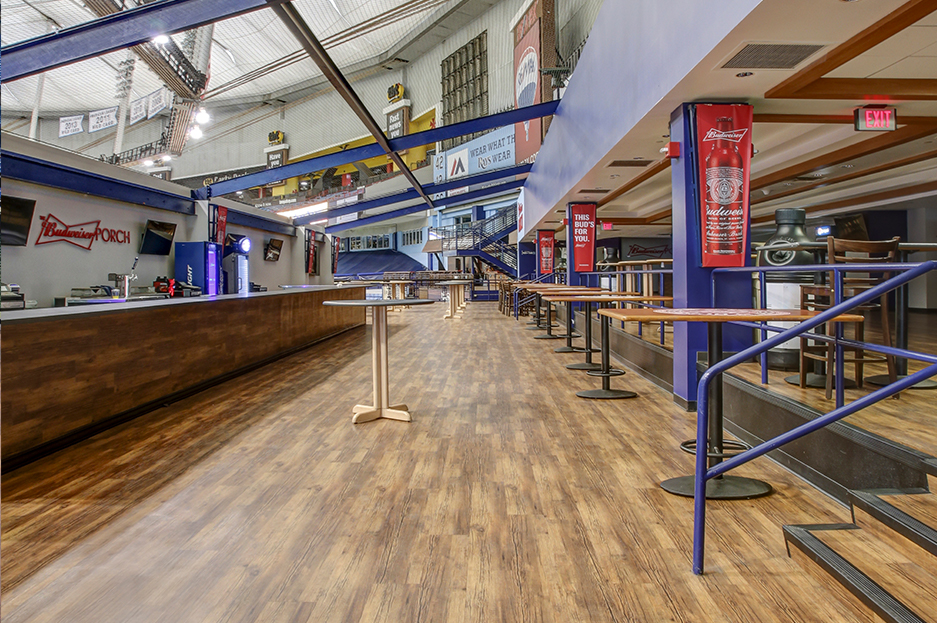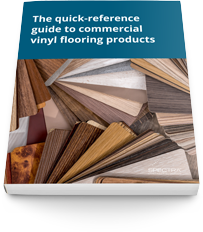LVT Flooring: What exactly is it?
Found everywhere from airports and hotel lobbies to schools, hospitals and more, LVT has vastly become one of the most popular commercial options in today’s flooring market. However, while its popularity is at an all-time high, we often hear many misconceptions about its characteristics and capabilities. To avoid confusion, we are going to examine the age-old question, what is LVT flooring? We will also take a look at how LVT flooring is made and the benefits of choosing LVT for your upcoming or next flooring project.
Trends in commercial flooring
Learn the latest in flooring materials, design and decision-making frameworks so you can select the best floor for your facility.
What is LVT Flooring?
Short for luxury vinyl tile, LVT is designed to replicate hard surface flooring materials such as stone or wood, yet provide many more practical benefits. Available in planks or tiles, LVT uses a realistic photographic print film and a clear vinyl layer that opens up a wide variety of design concepts. Even the most trained of eyes have a hard time distinguishing LVT from the products that it mimics.
To go the extra mile in understanding LVT, let’s take a look at how it’s made. LVT is manufactured through the following five primary processes.
1. Research and Development
From the beginning, research and development teams aim to simulate and evaluate new innovative concepts through trial and error. Large amounts of raw materials are mixed so that the team can study their interactions. The raw materials used in the production of LVT include polyvinyl chloride resins (PVC) and calcium carbonate. Once the team has a satisfactory compound to work with, it is ready to begin the calendering process.
2. Calendering Process
The calendering process uses a series of heated rollers to “roll or squeeze” the compound into a continuous sheet. By manipulating the rolls, the width and thickness of the sheet can be controlled with precise accuracy and consistency. Once the sheet is passed through the heated rolls, it is then sent through a cooling section and sent to lamination.
3. Lamination Process
Through the use of heat and pressure, lamination is a continuous process that bonds one layer to the next until all layers are fully formed. The tiles are constructed of the following four layers:
- Backing layer – Sound absorbing layer with textured grip
- Fill layer – Stability layer for indentation resistance
- Print layer – Certain premium types of LVT come manufactured with realistic, 3D visuals that can be installed to resemble ceramic or stone.
- Wear layer – The wear layer plays a crucial role in the lifespan of your tiles. Clear coatings such as aluminum oxide will keep your flooring from rapidly wearing.
Once the layers are fully formed, the sheet enters into the embossing section.
4. Embossing Process
Here, under heat and pressure, engraved rollers apply the textured design onto the face of the product which can be a light “tick” or a “deep” emboss. Once the texture is applied, the scratch and scuff Top Coat will be applied. The slabs then pass through an annealing oven that uses heated air to raise the temperature of the entire slab to a point that any stress between the layers are relieved. Once cooled back down, this process is added “insurance” to produce a stabilized product that will reduce the opportunity for “doming or cupping” due to stresses between the layers in the finished planks. From there the slabs are palletized and taken to Inspection, the final stop.
5. Inspection Process
During inspection, the slabs are brought into an air controlled room that will maintain the same temperature year round. This is important because it keeps the product in a uniform state during the milling process which helps to ensure consistent milling from one board to the next. Being able to inspect each slab before milling allows technicians to inspect and mark defective areas. The non-defected slabs will then be loaded into the press which offers alternative product sizes and is then sent to milling. Once milled, the product is boxed, wrapped, stacked on a pallet, and ready for shipment.

The Benefits of Choosing Luxury Vinyl Tile
Easy Installation
LVT can be easily installed in two ways, either with glue or with a loose-lay floor. Using newer loose-lay systems makes it possible to use LVT with minimal surface preparation. With this solution, flooring installation costs, as well as installation times, can be reduced.
Comfort
Luxury vinyl tile has a softer surface than other flooring materials, like wood or stone, which is more comfortable underfoot and sound reducing, which is a very important trait for many facilities.
Affordability
Traditional hardwood and stone flooring options are more costly than LVT. If you’re looking for a durable alternative at a much lower cost, look no further.
Resistant to whatever life throws at it
Everyday life is hard on flooring surfaces. Therefore, choosing a flooring material that guards against mishaps is crucial. LVT is easy to clean, won’t chip, and is resistant to moisture, which makes it an ideal option for kitchens, bathrooms, and areas below ground level.
To learn more about LVT, check out our quick-reference guide to vinyl flooring products. You’ll receive quick takeaways about the pros, cons, price and performance of LVT, VCT and vinyl sheet flooring. Download your guide today.

Reference guide to commercial vinyl flooring products
Take the guesswork out of vinyl product selection. This guide cuts through the noise, offering you quick takeaways about the pros, cons, price and performance of LVT, VCT and vinyl sheet flooring.
For similar pages, check out: EVP FLooring: What Exactly Is It? and SPC Flooring: What Exactly Is It?
